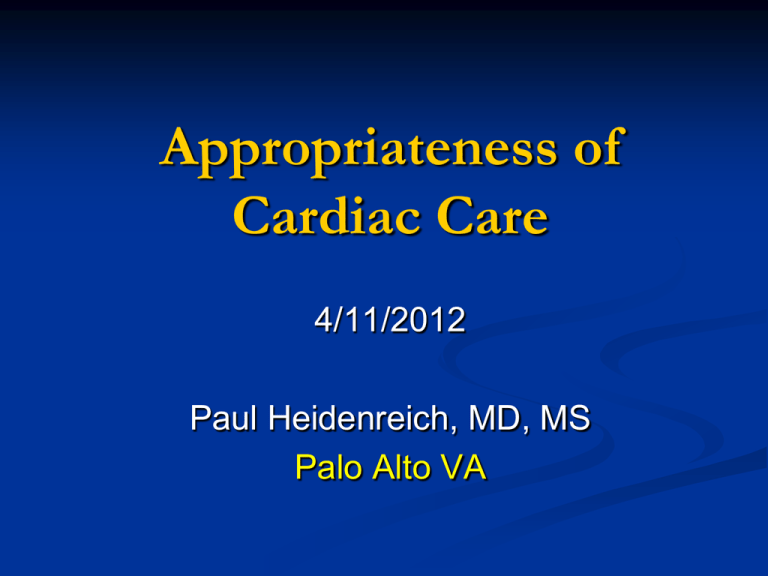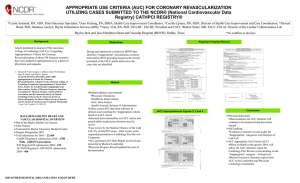Appropri
advertisement

Appropriateness of Cardiac Care 4/11/2012 Paul Heidenreich, MD, MS Palo Alto VA Relative Relationships Served on American College of Cardiology (ACC) appropriateness rating panel for echocardiography Currently on writing committee for ACC ICD/CRT appropriateness criteria Past research grant from Medtronic Outline Appropriateness as a measure of quality Examples of criteria Is US care appropriate? Echo, Stress Testing Echo, ICD, PCI Research in Progress: Two Interventions to improve appropriateness Why Appropriateness? Total Office Progressive Increase in Office Cardiac Imaging OP Hospital Levin Health Affairs, 2010 Need for Appropriateness: 15-fold Variation in Coronary Stenting/Angioplasty Dartmouth Atlas 2005 CMS Imaging Reporting Hospital Compare: CT Scans Hospitalcompare.hhs.gov Hospital Compare: Follow Up Mammograms Hospitalcompare.hhs.gov Procedure Utilization Review Prior approaches Review of individual cases Black box rules Third party gatekeepers ACC Survey of RBM/Prior Authorization Practice Ability of referring physicians to place orders 56% Educational benefit of interaction Physician selection of test without forced test substitution 92% 61% Transparency in decisions 72% Accuracy in review of clinical decision making Timeliness and avoiding clinical delay 69% 56% 0% 10% 20% 30% 40% 50% 60% 70% 80% 90%100% Poor or Very Poor Performance Goals of Appropriateness Measures - Create partnerships for rational/fair CV use of procedures and related reimbursement (clinicians, health plans, policymakers and payers) - Educate clinicians on their practice habits - Stewardship of health care resources - Improve cost effectiveness of CV procedures (imaging, stenting, devices) Understanding Quality in Procedure Utilization Underuse Failure to apply treatment in those likely to benefit Overuse Applying treatment to patients in whom risks > benefits Guidelines Appropriate Use Criteria Rand/UCLA Rating Method Adapted from Fitch K, et al. The RAND/UCLA Appropriateness Method User’s Manual, 2001, 4 Rating of Indications 7-9: Appropriate test for specific indication Test is generally acceptable and is a reasonable approach for the indication 4-6: Uncertain or unclear if appropriate for specific indication Test may be generally acceptable and may be a reasonable approach for the indication 1-3: Inappropriate test for specific indication Test is not generally acceptable and is not a reasonable approach for the indication Uncertain and Inappropriate Uncertain does NOT indicate that the procedure should NOT be performed for that indication, but rather more information/research is need to reach a firm conclusion Uncertain does NOT indicate that the procedure should not be reimbursed for that indication Inappropriate rate goal should never be 0%; emphasize reduction in patterns of inappropriate AUC and Coverage AUC are not coverage criteria but clinical benchmarking tools Coverage can be broader and AUC target clinical nuances Registry implementation: potential source of information to track usage of procedures after coverage approval AUC Development Completed Nuclear Imaging (SPECT) October 2005 Cardiac CT/CMR September 2006 Echocardiography (TTE, TEE) July 2007 Echocardiography (Stress) December 2007 Coronary Revascularization December, 2008 Revised Nuclear Imaging May 2009 Revised CT October 2010 Revised Echocardiography November 2010 Revised Coronary Revascularization January 2012 In Progress Multi-modality criteria Heart failure Acute chest pain Ischemic Heart Disease Vascular Disease Ultrasound Diagnostic Catheterization ICD/CRT Examples Revascularization PCI Echo ICD Coronary Revascularization Revascularization Criteria ~200 Clinical scenarios rated by 17 experts Based upon the potential benefit to be gained from PCI. Patients’ stratified by… Severity of coronary anatomy Magnitude of ischemia Intensity of medical therapy Severity of symptoms STEMI Patel, JACC 2009 ACS Algorithm Patel, JACC 2009 Appropriate use criteria for revascularization help measure quality… 23 Appropriate Use of PCI Percutaneous Coronary Intervention (PCI) Registry Variation in Inappropriate Use of PCI Chan JAMA 2011 Rate of Inappropriate PCI (%) Volume and Inappropriate PCI R=0.06 PCI Procedure Volume Chan JAMA 2011 CATH-PCI Reports … and uncover opportunities for cost savings or better resource deployment 700000 Procedures in CathPCI Registry 600000 500000 106589 20157 56589 Not Classifiable Inappropriate 400000 Uncertain 300000 Appropriate 200000 3.2% of PCI procedures considered inappropriate. If dropped to 2.2%= 44,000,000 USD 449410 100000 0 2010 Source: Chan et al, internal ACC analysis 29 Validation: Appropriate PCI Chan, JACC 2011 Validation: Uncertain Appropriateness PCI Chan, JACC 2011 Validation: Inappropriate PCI Chan, JACC 2011 Appropriate Use of Implantable Defibrillators ICD ICD Use in Primary Prevention All-Khatib, JAMA 2011 Rates of Non-Evidence Based ICD Implantation All-Khatib, JAMA 2011 Individual Reasons for Not Meeting Guidelines All-Khatib, JAMA 2011 Appropriate Use of Stress Imaging Inappropriate Stress Echo Douglas, JACC 2008 Appropriateness of Stress Echo in Valve Disease Douglas, JACC 2008 Appropriateness of Stress Imaging Gibbons JACC 2008 Inappropriate Stress Indications Gibbons,s JACC 2008 Appropriateness Classification (n=5,928) ACCF and United Healthcare Pilot % INAPPROPRIATE INDICATIONS % TOTAL STUDIES 44.5% 6.0% Asymptomatic, postrevascularization < 2 years after PCI, symptoms before PCI 23.8% 3.2% Evaluation of chest pain, low probability pt. Interpretable ECG and able to exercise 16.1% 2.2% Asymptomatic/stable symptoms, known CAD,< 1 year after cath/abnormal SPECT 3.9% 0.5% Pre-operative assessment. Low risk surgery 3.8% 0.5 % TOTAL 92.1% 12.4 % INDICATION Detection of CAD. Asymptomatic, low CHD risk Rates same between patients with RBM and without RBM review Appropriate Use of Echocardiography Inappropriate Echo Indications Rahimi AJC 2011 Inappropriate Echocardiograms Rahimi AJC 2011 Hospital and Provider Type: University of Miami Echo P<0.05 Willens JASE 2009 Inappropriate Echocardiograms Ward, JACC Imaging 2008 Inappropriate Echo Results Major includes wall motion abnormality, moderate valve disease, Ward, JACC Imaging 2008 pulmonary HTN, LVEF < 40%, RV dysfunction Repeat Echocardiograms: Less Appropriate by Criteria Ghatak, Echocardiography 2011 Appropriateness of Echocardiograms: VA Palo Alto Research Purpose To determine if a statement in the echocardiography report can lead to more appropriate studies. Intervention statement in the echo report: Positive Recommended in 2 weeks Recommended in 6 months Recommended in 1 year Negative Not recommended for at least 1 year Not recommended for at least 3 years Incorporated Into Work Flow Reader determines if follow-up statement should be added Reporting system randomly includes or does not include the statement Outcome Positive statement (follow up recommended by time period X months): Echo within X months -25% to + 50% 9 months to 18 months OK for 1 year f/u Negative statement (follow up not recommend for at least X months Follow-up Echo not done in X months Exclusion From Analysis (if N small) Echo performed for new indication Patient leaves the Palo Alto VA health care system before follow-up period Death Changed health systems Analysis Primary: first echocardiogram per patient Secondary: multiple echocardiograms per patient Progress Study Initiated 7/2012 1032 reports randomized 50:50 989 unique patients 849 negative recommendations 183 positive recommendations Follow Up Studies Follow-Up Studies after a Negative Recommendation 41 echo requests examined 9 clearly inappropriate Plan to enroll until we have 100 inappropriate follow-up echocardiograms Left Ventriculography Use of Left Ventriculography Test is not “ordered”. Decision made by the invasive cardiologist at the time of coronary angiography. Adds contrast (small risk of worsening renal function) Adds radiation (minimal risk of cancer) Appropriateness Left Ventriculography Use during coronary angiography >80% among Aetna patients despite recent echocardiogram Does the rate vary across facilities? Witteles, AHJ 2012 Variation in LVgram Use Left Ventriculography During Coronary Angiography 100% 90% 80% 70% 60% 50% 40% 30% 20% 10% 0% Individual VA Hospitals LV Gram Appropriateness Intervention 1) Have VA providers of left ventriculography (invasive cardiologists) rate appropriateness of different scenarios. LV Gram Appropriateness Intervention 2) Determine appropriateness using the VA’s national catheterization laboratory reporting system LV Gram Appropriateness Intervention 3) Feedback performance to each VA laboratory. Progress? Appropriateness of Echo Rahimi AJC 2011 Nuclear Medicine Use Levin Health Affairs, 2010








